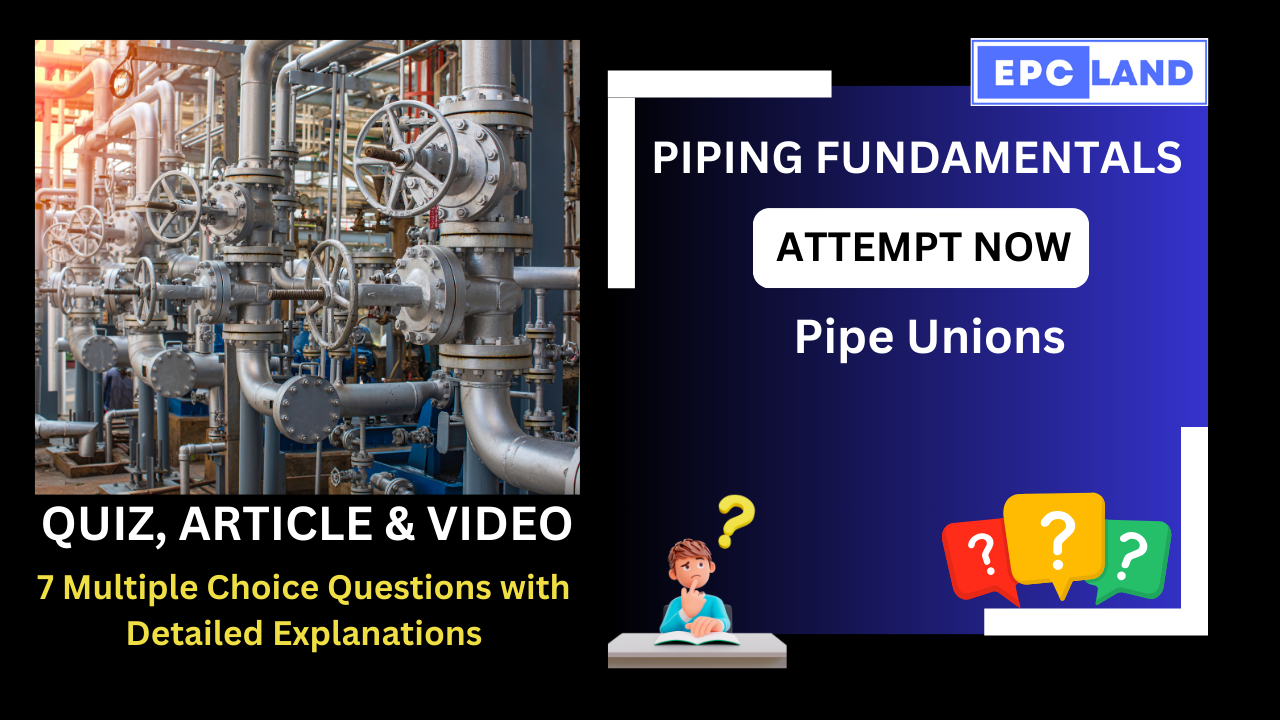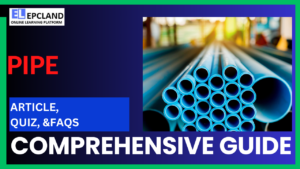1. What is the main function of the male end in a pipe union?
Options:
Explanation: The main function of the male end is to mate with the internal threads of the female end in a pipe union.
2. In which type of pipe union are flanges secured together using bolts and nuts?
Options:
Explanation: Flange unions consist of flanges secured together using bolts and nuts.
3. What is the primary advantage of copper unions in pipe systems?
Options:
Explanation: Copper unions offer excellent corrosion resistance and high thermal conductivity.
4. What is a potential disadvantage of pipe unions?
Options:
Explanation: Improper installation or damage to the seating surface can lead to potential leakage in pipe unions.
5. What parameter should be considered when specifying pipe unions based on application requirements?
Options:
Explanation: Material grade should be considered when specifying pipe unions based on application requirements, including pressure, temperature, and corrosion resistance.
6. What industry commonly uses pipe unions for connecting pipes in sprinkler systems and standpipe networks?
Options:
Explanation: The fire protection industry commonly uses pipe unions for connecting pipes in sprinkler systems and standpipe networks.
7. What consideration should be made when deciding between ground joint and flange unions?
Options:
Explanation: When deciding between ground joint and flange unions, consideration should be given to pressure, temperature, and vibration requirements.
Short Article on Pipe Unions
Introduction
Pipe unions are versatile pipe fittings that facilitate the connection of two pipes while enabling easy disconnection for maintenance or inspection. They are widely used in various applications, including plumbing, fire protection systems, and process piping.
Structure and Components
A pipe union typically comprises three main components:
- Male End: The male end features external threads that are designed to mate with the internal threads of the female end.
- Female End: The female end exhibits internal threads that align with the external threads of the male end.
- Nut: The nut serves as the connector, tightening the joint between the male and female ends to create a secure seal.
Types of Pipe Unions
Pipe unions are categorized into two primary types:
- Ground Joint Union: These unions feature a conical seat that interlocks with the male and female ends, creating a strong, metal-to-metal seal. Ground joint unions are typically utilized in high-pressure applications.
Ground Joint Union Pipe
- Flange Union: These unions consist of a pair of flanges, one attached to each pipe end. The flanges are secured together using bolts and nuts, forming a rigid connection. Flange unions are commonly used in low-pressure applications.
Flange Union Pipe
Materials Used for Pipe Unions
The selection of material for pipe unions depends on specific application requirements and environmental conditions. Common materials include:
- Carbon Steel: Affordable and widely used, carbon steel unions are suitable for moderate pressure and temperature applications.
- Stainless Steel: Resistant to corrosion and high temperatures, stainless steel unions are ideal for applications with stringent chemical resistance needs.
- Cast Iron: Robust and cost-effective, cast iron unions are often employed in fire protection systems and low-pressure applications.
- Copper: Possessing excellent corrosion resistance and high thermal conductivity, copper unions are favored in plumbing and heating systems.
- Brass: Offering a combination of strength, corrosion resistance, and thermal conductivity, brass unions are widely used in plumbing and low-pressure applications.
Applications of Pipe Unions
Pipe unions find extensive applications in various industries:
- Plumbing: Connecting pipes in water supply, waste disposal, and heating systems.
- Fire Protection: Joining pipes in sprinkler systems and standpipe networks.
- Process Piping: Connecting pipes in industrial processes involving fluids, gases, and chemicals.
- Instrumentation: Mounting flow meters, pressure gauges, and other instruments to piping systems.
Advantages of Pipe Unions
Pipe unions possess several advantages that make them popular choices in various applications:
- Ease of Installation and Disassembly: Pipe unions can be easily installed and disconnected, allowing for quick access to components for maintenance or repair.
- Interconnectivity: They can connect pipes of different sizes and materials, providing flexibility in piping configurations.
- Durability: Properly installed and maintained pipe unions offer long-lasting performance.
Disadvantages of Pipe Unions
Pipe unions also have some drawbacks that should be considered:
- Potential Leakage: Improper installation or damage to the seating surface can lead to leakage.
- Higher Cost: Compared to some other types of pipe fittings, pipe unions typically have a higher price tag.
Specifying Pipe Unions
When specifying pipe unions, consider the following parameters:
- Manufacturing Standard: Ensure compliance with relevant industry standards, such as ASME B16.11 or BS 3799.
- Material Grade: Select the material based on the application’s pressure, temperature, and corrosion resistance requirements.
- Dimension/Pressure Class: Choose the appropriate size and pressure rating based on the specific application.
- Type of Union: Decide between ground joint or flange unions based on pressure, temperature, and vibration requirements.
- Value-Added Services: Consider additional services, such as galvanizing, coating, or polishing, to enhance corrosion resistance and aesthetic appeal.
Conclusion
Pipe unions are versatile and reliable tools for connecting pipes in various applications. Their ease of installation and disconnection, ability to join different pipe sizes and materials, and long-lasting performance make them a valuable asset in plumbing, fire protection, and process piping systems
Table of Contents
Don’t miss the Course on Effective Isometrics Management: Check Now
Enrollment Link
Recommended courses (Published on EPCLand)
- Complete Course on Piping Engineering
- Basics of Piping Engineering
- Piping Layout Engineering
- Piping Material Engineering
- Piping Stress Analysis
- Material Requisitions
- Piping Material Specifications
- Valve Material Specifications
- Plant Design & Layouts-OISD 118
- Isometric Management
Library of Technical Articles
Don’t miss out the collection of 15+ articles on following topics:
- Basics of Oil and Gas Industry
- Valves
- Testing
- Tank
- Piping Bulk Items
- Pipe
- Metallurgy
- Piping Materials
- Layout
- Instrumentation
- Heat Exchanger
- Type of Contracts
- Codes and Standards
- ASTM Standards
- Articles on Piping Specialty Items
Video details of Complete Course on Piping Engineering
Why Enroll in the EPCLand
Proven Track Record– PTR
Activities & Achievements before launching EPCLand
- Published more than 50+ short courses
- 3000+ Enrolments
- More than 3,500,00 Minutes of watch hours in the last 2 years
- 4000+ Students in 100+ Countries
- Rating of 4+ out of 5
- 1000+ YouTube Videos
- 8K+ Subscribers
What Students will Learn
- Codes & Standards of the Energy Sector
- Piping Material Engineering
- Piping Layout Engineering
- Stress Analysis
Interesting facts
- All the published courses have been developed by Industry Experts with more than 2 decades of experience
- Content is based on Practical experience and real-time problems.
- Content is designed and organized in such a manner that it can be easily grabbed.
- Complete website, Blogs and Quiz sections are Planned, Designed and published by myself (About me: Atul Singla)
- Complete flexibility of Time & Location, Students can access the content from anywhere & anytime
- Moreover, once enrolled, the content can be access as many times as you want, which helps in understand the fundamentals in a better way.
Conclusion
In conclusion, our courses are meticulously crafted by industry experts with over two decades of hands-on experience. The content is rooted in practical knowledge, addressing real-time problems. The material is thoughtfully designed and organized for easy comprehension. Every aspect, from the website to blogs and quizzes, has been planned, designed, and executed by Atul Singla, ensuring a comprehensive and seamless learning experience. With the flexibility of accessing the content at any time and from any location, students have the freedom to learn on their terms. Furthermore, enrollment grants unlimited access, allowing learners to revisit the material as often as needed, fostering a deep understanding of the fundamentals.



